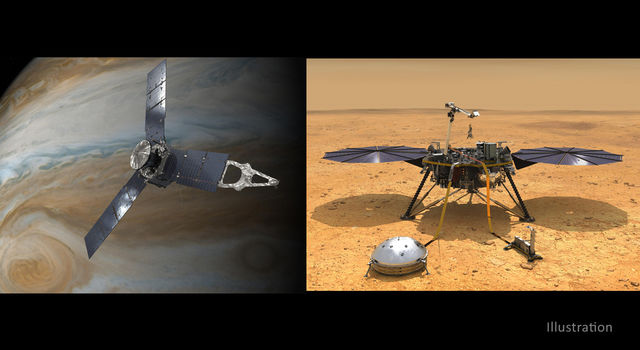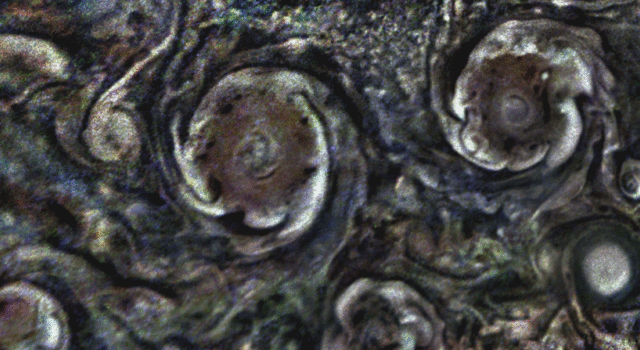Blogs | Dawn Journal | May 31, 2014
Survey Orbit: A Truly Extaordinary View
Dear Dawnosaurs,
Silently streaking through the main asteroid belt, emitting a blue-green beam of xenon ions, Dawn continues its ambitious interplanetary expedition. On behalf of creatures on distant Earth who seek not only knowledge and insight but also bold adventure, the spacecraft is heading toward its appointment with Ceres. In about 10 months, it will enter orbit around the ancient survivor from the dawn of the solar system, providing humankind with its first detailed view of a dwarf planet.
This month we continue with the preview of how Dawn will explore Ceres. In December we focused on the "approach phase," and in January we described how the craft spirals gracefully into orbit with its extraordinary ion propulsion system. The plans for the first observational orbit (with a marvelously evocative name for a first examination of an uncharted world: RC3 — is that cool, or what?), at an altitude of 8,400 miles (13,500 kilometers), were presented in February. Last month, we followed Dawn on its spiral descent from each orbital altitude to the next, with progressively lower orbits providing better views than the ones before. Now we can look ahead to the second orbital phase, survey orbit.
In survey orbit, Dawn will make seven revolutions at an altitude of about 2,730 miles (4,400 kilometers). At that distance, each orbit will take three days and three hours. Mission planners chose an orbit period close to what they used for survey orbit at Vesta, allowing them to take advantage of many of the patterns in the complex choreography they had already developed. Dawn performed it so beautifully that it provides an excellent basis for the Ceres encore. Of course, there are some adjustments, mostly in the interest of husbanding precious hydrazine propellant in the wake of the loss of two of the spacecraft's four reaction wheels. (Although such a loss could have dire consequences for some missions, the resourceful Dawn team has devised a plan that can achieve all of the original objectives regardless of the condition of the reaction wheels.)
We had a preview of survey orbit at Vesta four years ago, and we reviewed the wonderfully successful outcome in September 2011. When we develop the capability to travel backwards in time, we will insert a summary of what occurred in survey orbit at Ceres here: _______…… Well, nothing yet. So, let's continue with the preview.
As in all phases at Ceres (and Vesta), Dawn follows what space trajectory experts (and geeks) call a polar orbit. The ship's course will take it above the north pole, and then it will sail south over the side bathed in the light of the sun. After flying over the south pole, Dawn will head north. Although the surface beneath it will be dark, the spacecraft will be high enough that it will not enter the dwarf planet's shadow. The distant sun will constantly illuminate the large solar arrays.
The leisurely pace in survey orbit allows the explorer to gather a wealth of data during the more than 37 hours on the day side. It will train its science camera and visible and infrared mapping spectrometer (VIR) on the surface lit by the sun. The camera will collect hundreds of images using all seven of its color filters. It will reveal details three times finer than it observed in RC3 orbit and 70 times sharper than the best we have from the Hubble Space Telescope. VIR will acquire millions of spectra to help scientists determine the minerals present as well as the temperature and other properties of the surface. While the sensors are pointed at the surface, the main antenna cannot simultaneously be aimed at Earth, so the robot will store its pictures and spectra.
One Cerean day, the time it takes Ceres to rotate once on its axis, is a little over nine hours. (For comparison, Earth, as some of its residents and visitors know, takes 24 hours. Jupiter turns in just under 10 hours, Vesta in five hours and 21 minutes, and your correspondent's cat Regulus in about 0.5 seconds when chasing a laser spot.) So as Dawn travels from the north pole to the south pole, Ceres will spin underneath it four times. Dawn will be close enough that even the wide field of view of its camera won't capture the entire disc below, from horizon to horizon, but over the course of the seven orbits, the probe will see most of the surface. As in developing the plan for Vesta, engineers (like certain murine rodents and male humans) are keenly aware that as careful, as thorough, and as diligent as they are, their schemes don't always execute perfectly. In the unknown, forbidding depths of space with a complex campaign to carry out, glitches can occur and events can go awry. The plan is designed with the recognition that some observations will not be achieved, but those that are promise great rewards.
Most of the time, the spacecraft will gaze straight down at the alien terrain immediately beneath it. But on the first, second, and fourth passages over the day side of Ceres, it will spend some of the time looking at the limb against the blackness of space. Pictures with this perspective will not only be helpful for establishing the exact shape of the dwarf planet but they also will provide some very appealing views for eager sightseers on Earth.
In addition to using the camera and VIR, Dawn will measure space radiation with its gamma ray and neutron detector (GRaND). GRaND will still be too far from Ceres to sense the nuclear particles emanating from it, but recording the radiation environment will provide a valuable context for the sensitive measurements it will make at lower altitudes.
When Dawn's orbit takes it over the dark side, it will turn away from the dwarf planet it is studying and toward the planet it left in 2007 where its human colleagues still reside. With its 5-foot (1.52-meter) main antenna, it will spend most of the day and a half radioing its precious findings across uncounted millions of miles (kilometers) of interplanetary space. (Well, you won't have to count them, but we will.)
In addition to the instrument data it encodes, Dawn's radio signal will allow scientists and engineers to measure how massive Ceres is. By observing the Doppler shift (the change in frequency caused by the spacecraft's motion), they can determine how fast the ship moves in orbit. Timing how long the signals (traveling at the universal limit of the speed of light) take to make the round trip, navigators can calculate how far the probe is and hence where it is in its orbit. Combining these (and including other information as well) allows them to compute how strongly Ceres pulls on its orbital companion. The strength of its gravitational force reveals its heft.
By the end of survey orbit, Dawn will have given humankind a truly extraordinary view of a dwarf planet that has been cloaked in mystery despite more than 200 years of telescopic studies. As the exotic world of rock and ice begins to yield its secrets to the robotic ambassador from Earth, we will be transported there. We will behold new landscapes that will simultaneously quench our thirst for exploration and ignite our desire for even more. It is as humankind reaches ever farther into the universe that we demonstrate a part of what it means to be human, combining our burning need for greater understanding with our passion for adventure and our exceptional creativity, resourcefulness and tenacity. As we venture deeper into space, we discover much of what lies deep within ourselves.
Dawn is 7.2 million miles (12 million kilometers) from Ceres. It is also 1.87 AU (174 million miles, or 280 million kilometers) from Earth, or 695 times as far as the moon and 1.84 times as far as the sun today. Radio signals, traveling at the universal limit of the speed of light, take 31 minutes to make the round trip.
Dr. Marc D. Rayman
11:00 p.m. PDT May 31, 2014
P.S. This is the 101st Dawn Journal. Only 99 more to go before cake and balloons again!
TAGS:DAWN, CERES, VESTA, SOLAR SYSTEM, SPACECRAFT, MISSIONS, DWARF PLANETS








